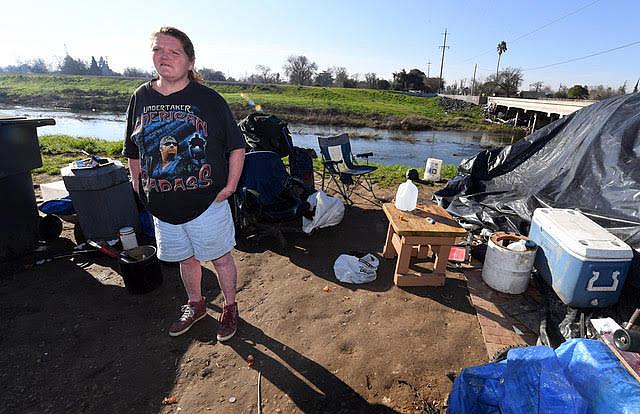Do people still fall through the health safety net?

(Photo by Calixtro Romias/The Record)
Do people still fall through the health safety net? Yes. Even in 2019. In America.
No one – with the exception of some wealthy people – should be walking around without health insurance. No one with cancer, diabetes, heart disease or a long-term bleeding infection should go without or be denied treatment.
But it happens. Every day. Their stories are out there, waiting to be told.
They are the working poor, the unemployed, the physically and mentally disabled, the non-English speakers, the immigrants, the homeless. No one label fits everyone, but the single label that I continually heard, the one the experts, front-line outreach workers, and health and nonprofit leaders referred to most often as falling through the net were undocumented immigrants. Roughly 49,000 of them in San Joaquin County alone, the area of my focus for my 2018 Data Fellowship project, “Thousands slip through health safety net.”
Even when the facts are presented and real people share their stories, some readers don’t believe it.
“I don’t understand this, being that I work at a health clinic that services Medi-Cal. We have dental, GI, ENT, primary, women’s health, prenatal,” one person commented on a Facebook post that shared one of my stories. To which another poster replied: “Hey, make me a dentist appointment. I need to go.”
Another poster explained why she will no longer go to the primary provider of medical care for the poor in San Joaquin County: “$6,892.33 to be ‘seen’ at the S.J. County hospital in October. I was never seen by a doctor and was never in the actual ER. I was not given any medication. I had an EKG for chest pains and that was it. I will never go again.”
That’s an example from one of many people who feel taken advantage of by an expensive, seemingly overburdened health care system. Their reaction to the hurdles they faced: just don’t go back.
But Cristino Abarca, a 28-year-old farm worker from rural Mexico whose first language is an indigenous dialect, has no choice but to take his chances and go back for treatments at the county’s only public hospital. He’s a single man with no family in the area, undocumented, uninsured and has lived under the radar in Stockton for the past eight years. That is until earlier this year when he became the victim of a vicious robbery in which the suspect, having already shot him five times, fired two more rounds into Abarca as he lay bleeding on the ground.
Abarca’s biggest worry about seeking treatment for his lingering injuries: “When you go, they always ask about the insurance.”
I got lucky sourcing Abarca. A fellow reporter had previously contacted him as a crime victim, noting his citizenship status in her story. I had been having difficulty getting undocumented immigrants living in the area to share their health care experiences. Reaching out to social service agencies such as Catholic Charities and El Concilio that I’d worked closely with previously wasn’t bearing fruit this time, as their clients proved to be too scared in the current political climate to step forward. Also, the agencies themselves were uncharacteristically reluctant to offer much assistance. Similarly, organizers of area health fairs were resistant to my speaking with participants about their citizenship status. So I went to labor camps, housing complexes and even out to work sites. Nothing.
Eventually, I met success at a day-labor pickup point at a corner gas station. When I first walked over to a group of men all eager for work, their initial enthusiasm faded as soon as I explained I was a reporter – with no job to offer them – who wanted to talk about health care. Once they understood why I was there, most of them wandered away. But some stayed around and I got my interviews.
Finding the right people to speak on such a sensitive subject that could lead to deportation proved to be more time-consuming than I had anticipated, but perseverance and hitting the streets in a lot of places paid off.
I used that same technique earlier in my research looking for unsheltered homeless people. I made a point of not going out to the homeless camps close to resources such as shelters, Stockton’s two homeless-oriented medical clinics, federally qualified health centers or the public hospital. Instead, I went out and found more isolated locations where the unsheltered were hanging out. Many sought the isolation, they told me, because of their poor health. And furthermore, the vast majority do have some kind of health condition that most people would seek treatment for. With the successful expansion of Medicaid in California, almost every homeless person I interviewed was insured. That’s a big change from five or six years ago.
But despite having insurance, there is a lot of confusion on how to obtain appropriate care. And when some do get in to see a practitioner, the quality of the visit is often unsatisfactory and the health condition persists. My takeaway is that while fewer people are outside the safety net than a few years ago, we must now seriously examine the quality of care being offered by safety net resources.
The data used to inform my stories came from the U.S. Census Bureau, American Community Survey, California Health Interview Survey, California Department of Health Care Services (Medi-Cal), Public Policy Institute of California, Covered California and the UC Berkeley Labor Center, as well as local sources such as the local Medicaid managed care provider, Health Plan of San Joaquin.
